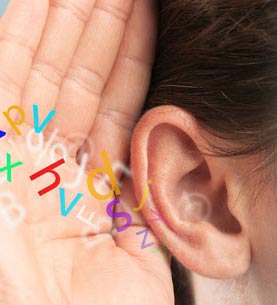
Hearing Loss
What is hearing loss?
Hearing loss is an auditory deficiency that is
either congenital (taking place before birth) or acquired (appearing after birth). Before enumerating the different types of hearing
loss, we will provide an introduction to the anatomy of the ear.
The
inner ear is similar to a microphone. Its main role is to capture the sound that reaches it and to transmit
it to the brain in the form of electric waves through nerve fibers. The middle ear’s main role is to carry the sound
vibrations from the outer ear to the inner ear. The different types of hearing loss are therefore
presented:
- Conductive hearing loss, which is due to a lesion of the outer or middle ear. Consequently, the sound has difficulties reaching the inner ear, or our body’s microphone (imagine that the microphone is covered preventing sound from reaching it).
- Perceptive or sensorineural hearing loss, which is due to damage to the hearing organ or the auditory nerve in the inner ear. This implies either damage to the microphone itself, or its link with the brain.
- Mixed hearing loss is the combination of both types of hearing loss.

Image taken from: https://www.fairview.org/sitecore/content/Fairview/Home/Patient-Education/Articles/English/a/n/a/t/o/Anatomy_of_the_Ear_83594
What are the clinical signs?
The degree of hearing loss may range from mild
auditory deficiency to total hearing loss. Therefore, depending on its severity, sensory deprivation may
prevent or hinder the auditory stimulation which is essential for the harmonious development of language
and communication and, consequently, social integration.
Hearing loss may therefore have an impact on
language acquisition, since children with hearing loss do not acquire their mother tongue in a natural
and spontaneous way. We can observe:
How to act?
- Reduced vocabulary since the child either does not perceive words or perceives them in a distorted manner.
- Difficulty in sentence composition.
- Difficulty in understanding verbal messages.
- Alterations in language form (articulation, speech, voice tone and voice pitch) seeing that the child cannot hear themselves speak.
It is
to be noted that screening as well as early intervention with regards to a child’s hearing loss improve
their chances to better develop their language and integration with their surroundings. Actually, in some
countries, hearing loss is systematically screened at birth while in other countries, such as Lebanon, this
is done at the parents’ request.
The
situation of each person with hearing loss is unique. Some benefit from classic hearing aids. Others with
more severe cases need a cochlear implant. Nevertheless, all people with deafness benefit from the specific
help of a speech therapist in terms of communication and language development.
What is a cochlear implant?
For a child born with hearing loss, early implant in addition to support through speech therapy will offer satisfactory results in the development of oral language. In fact, in the case of a child born with hearing loss, the speech therapist’s role is fundamental for the first interactions, and for language acquisition in a later stage.A cochlear implant is a surgically inserted hearing aid that stimulates the auditory nerve in the inner ear. This implant will thus replace the “microphone” of the inner ear. It consists of two parts: one internal and the other external. After placement of the implant, precise adjustments and specific speech therapy will be essential.
Early education is therefore essential in order
to develop the child’s communication and to prepare them in the acquisition of language by developing
their listening skills and by making them aware of the auditory world, and of the verbal and non-verbal
communication to which they are exposed. This will also contribute to the development of the required
skills to recognize the different surrounding sounds and the meanings of words.
For children whose hearing loss appeared after
the development of their language, the speech therapist’s role is to assess to the child’s current
language skills and to objectify the delay with regards to their age. Then, the speech therapist will
help the child recover their delay by providing them with the adequate means that will help them
understand their auditory environment. Some examples include visual aids, sign language, manually coded
language which facilitates lip reading thanks to codes that follow the lips’ movements.
This support can be applied to all cases of
hearing loss regardless of its severity and the age of the subject and is essential throughout
schooling. Indeed, a speech therapist will be required to help the child when learning to write in order
to ensure that they perceive the different sounds in the language and their differences, all while
collaborating with their teachers.
Parental support is also paramount in order to
ensure the harmonious development of the child within the family. Thus, the speech therapist will
provide information to the parents regarding hearing loss and language development. They will also help
parents use specific strategies that will enable them to easily exchange with their child and
communicate with them in the most natural way possible.
Regarding hearing loss occurring during
adulthood, the speech therapist will accompany the patient and help them better perceive and understand
the different sounds in their environment and speech sounds made possible through the use of hearing
aids or a cochlear implant. The speech therapist’s role is therefore complementary to the adjustment of
the hearing aid by the hearing care professional.


